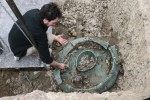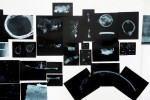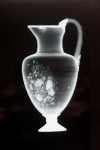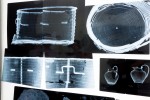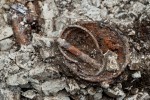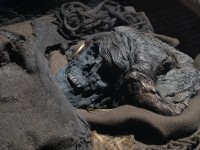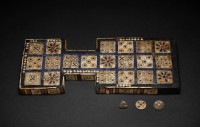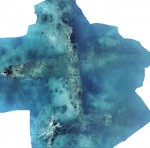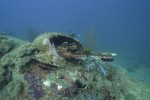 The catacombs of Santa Domitilla, the oldest network of early Christian burials, covers 7.4 miles and goes down four levels and 200 feet with 26,250 individual tombs. Flavia Domitilla was the niece of the emperor Vespasian who was exiled by her cousin Domitian for religious irregularities (ancient Roman sources say she was convicted of Atheism, the Talmud says she was a convert to Judaism, Eusebius and Jerome say she was condemned as a Christian). She was not buried in the catacomb that bears her name, but it was her property — a farm outside the city — and she permitted its use as a cemetery for Christians, first members of her household, then whoever. The burials in the catacombs date from the 2nd to the 5th centuries.
The catacombs of Santa Domitilla, the oldest network of early Christian burials, covers 7.4 miles and goes down four levels and 200 feet with 26,250 individual tombs. Flavia Domitilla was the niece of the emperor Vespasian who was exiled by her cousin Domitian for religious irregularities (ancient Roman sources say she was convicted of Atheism, the Talmud says she was a convert to Judaism, Eusebius and Jerome say she was condemned as a Christian). She was not buried in the catacomb that bears her name, but it was her property — a farm outside the city — and she permitted its use as a cemetery for Christians, first members of her household, then whoever. The burials in the catacombs date from the 2nd to the 5th centuries.
 Because of its great size and complexity and extremely high moisture levels (it’s 90-100% humidity at all times down there), the Domitilla catacomb has long been a conservation challenge. Traditional restoration methods aren’t effective in this environment, but moss, algae, mold, smoke, dirt and calcium carbonate concretions thrive, so much so that they completely obscured the frescoes beneath. In 2009, lasers came into the mix when the entire rabbit warren was 3D scanned and mapped down to the smallest detail for the first time.
Because of its great size and complexity and extremely high moisture levels (it’s 90-100% humidity at all times down there), the Domitilla catacomb has long been a conservation challenge. Traditional restoration methods aren’t effective in this environment, but moss, algae, mold, smoke, dirt and calcium carbonate concretions thrive, so much so that they completely obscured the frescoes beneath. In 2009, lasers came into the mix when the entire rabbit warren was 3D scanned and mapped down to the smallest detail for the first time.
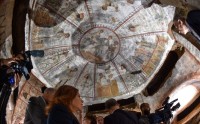 Three years ago, lasers rode to the rescue again, only this time they were used to clean the dirt and contaminants from the blackened frescoes on the ceilings and walls of unrestored chambers. This week, the Vatican unveiled to the press the first laser-restored spaces in the catacombs of Santa Domitilla.
Three years ago, lasers rode to the rescue again, only this time they were used to clean the dirt and contaminants from the blackened frescoes on the ceilings and walls of unrestored chambers. This week, the Vatican unveiled to the press the first laser-restored spaces in the catacombs of Santa Domitilla.
“The walls and ceilings were covered in algae, smoke residue and calcium from the damp,” said Barbara Mazzei, who led the team. “We knew there were frescoes under there, and the lasers let us get to them.”
Ms Mazzei said developments in laser technology had allowed the frescoes to be exposed without the risk of damage that removing the grime manually might have caused.
The frequency of the 2mm laser beams can be adjusted to eliminate certain colours — in this case the black of the hard residue. “We worked millimetre by millimetre to lift the grime off,” Ms Mazzei said.
Working in two tombs, they found stunning biblical images, including Jesus feeding the 5000 with bread and fish, as well as a baker with a grain measure and a cycle of frescoes showing grain arriving by ship in Rome from Egypt and bread being sold in the city. “These were rich bakers who had real prestige in Rome because the emperor guaranteed bread, as well as circuses, to the people,” Ms Mazzei said.
 Two areas have been fully restored. The first is a 3rd century chamber decorated with frescoes that include multiple pagan motifs. Cupids are popular in this space, mainly in smaller tombs that were probably used to inter children. This area also shows the scars of medieval looters. Frescoes were stripped from the walls by tomb raiders who made a pretty penny cutting the art off the walls and selling them or keeping them as personal trophies.
Two areas have been fully restored. The first is a 3rd century chamber decorated with frescoes that include multiple pagan motifs. Cupids are popular in this space, mainly in smaller tombs that were probably used to inter children. This area also shows the scars of medieval looters. Frescoes were stripped from the walls by tomb raiders who made a pretty penny cutting the art off the walls and selling them or keeping them as personal trophies.
The second restored space is the cubicle of the bakers (“dei fornai”). Christ and the Apostles decorate the walls alongside scenes of bakers. As well as glorifying the profession and their sponsors, the frescoes also have great symbolic significance because bread loomed large in Christian iconography (loaves and fishes, Last Supper, etc.).
 Also looming large on the frescoes in this cubicle is a name written in all caps in black charcoal: BOSIO. This was not left in antiquity. It’s the name of the man who rediscovered the catacomb almost a thousand years after it had fallen into disuse and been forgotten.
Also looming large on the frescoes in this cubicle is a name written in all caps in black charcoal: BOSIO. This was not left in antiquity. It’s the name of the man who rediscovered the catacomb almost a thousand years after it had fallen into disuse and been forgotten.
Antonio Bosio was the illegitimate son of Giovanni Ottone Bosio, a Knight of Malta who fought in and assiduously documented the Great Siege of Malta when the Ottoman Empire tried and failed to invade the island in 1565. When he wasn’t defending against far superior forces in months-long sieges, Giovanni Ottone busied himself having sex with a servants and murdering a fellow knight from an opposing political faction in St. Peter’s Square. He eventually got amnesty for the latter activity; he got a son from the former.
Antonio was born in 1575 and was raised by his uncle Giacomo in Rome. Giacomo adopted the boy and saw to it he received a thorough education in the humanities. This was a seminal time in the history of paleochristian archaeology. The catacomb of the Giordani was discovered in 1578, a major find during a period when only a handful of early Christian underground burial galleries were known. The Giordani Catacomb, a great labyrinthine structure replete with frescoes and inscriptions in Greek and Latin, was larger and more complex than any of them.
He was just a child when Antonio first learned about the vast cities of the dead underneath his feet from his teachers and friends of his uncle’s. His fascination with these places was sealed then and only increased over time. Antonio Bosio left his name on the catacomb wall on December 10th, 1593, when he was just 17 years old. At the time he thought this network was part of the large complex of the catacombs of Saint Calixtus. It wouldn’t be recognized as the Domitilla catacomb until the 19th century, thanks to the efforts of archaeologist Giovanni Battista de Rossi.
Bosio’s foray into Domitilla’s realm was also his first brush with death in the catacombs. Young Antonio, antiquary Pompeo Ugonio and a small group of other foolhardy explorers went too deep into the tunnels and couldn’t make out their return path. Then their lights went out because they’d been down there longer than they planned. Bosio would later say about this experience: “I began to fear that I should defile by my vile corpse the sepulchres of the martyrs.”
They made it out alive in the end, and Antonio spent the next 36 years studying the catacombs and all the relevant literature he could read, including all the lives of saints, histories of the church, patristic writings in Greek and Latin. Whenever he encountered a reference in the ancient sources to a possible site of a catacomb, he would explore the area over and over, looking for possible entry sites. If he heard of an accidental archaeological find during construction of a basement or foundations, he dropped everything to check it out, taking enormous personal risks to crawl through structurally unsound, collapsed structures.
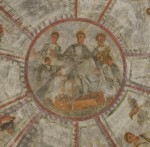 Even if the roof didn’t fall in on him, exploring the catacombs could still be fatal because the warrens of corridors, chambers and niches are so complex it’s far easier to get lost in them than it is to find your way out. His graffiti had the practical purpose of marking his path should he lose his way. Perhaps his giant John Hancock in the cubicle of the Bakers helped save his life.
Even if the roof didn’t fall in on him, exploring the catacombs could still be fatal because the warrens of corridors, chambers and niches are so complex it’s far easier to get lost in them than it is to find your way out. His graffiti had the practical purpose of marking his path should he lose his way. Perhaps his giant John Hancock in the cubicle of the Bakers helped save his life.
Bosio was a true pioneer in this field of study, so even though his methods bear no relevance to archaeology as we know it today, and he had an unfortunate habit of writing his name all over ancient frescoes, he earned the appellation he is still known by today, the Christopher Columbus of the Subterranean New World, fair and square.
The upgrades to the Domitilla catacombs include a new, small but well-appointed museum in the catacomb. It features artifacts like sarcophagus fragments, busts and inscriptions discovered during the excavations and restoration, and underscores the overlap between the art of early Christianity and Roman polytheism. The museum isn’t ready for the public yet. The hope is it will be open by the end of June. The newly restored areas of the catacombs won’t be open to visitors for months.

